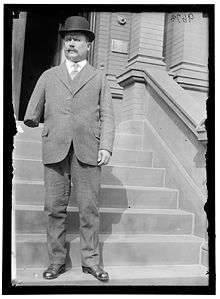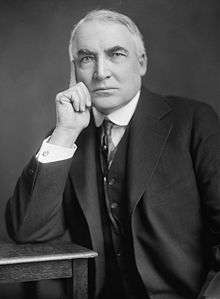Bucareli Treaty
The Bucareli Treaty (Spanish: Tratado de Bucareli), signed on 1923, was an agreement that attempted to resolve important issues in Mexico–United States relations. It was officially called "Convención Especial de Reclamaciones" (English: Special Convention of Claims), for losses sustained by citizens or companies of the United States of America because of the Mexican Revolution.[1][2][3][4][5]
The treaty sought to channel the demands of U.S. citizens for alleged damage to their property caused by internal wars of the Mexican Revolution during the period between 1910 and 1921.[2][3][4] The meetings were held in Mexico City and were conducted in a federal government owned building located on #85 Avenida Bucareli (therefore the treaty nickname). Negotiations began on May 15, 1923 and ended on August 13 of that year. The treaty was signed by President Álvaro Obregón primarily to obtain diplomatic recognition from the U.S. government led by President Warren G. Harding, but were never formally approved by the congresses of both countries.[6] The Bucareli Treaty was canceled shortly after by the President Plutarco Elías Calles.[7]
History

The situation of Mexico in which the treaty was signed was marked by political instability and constant military revolts. Part of the relative weakness of government of Álvaro Obregón came from the fact that the United States had not recognized its post-revolutionary regime.[8] The Constitution of 1917, with a strong socialist and nationalist influence, had hurt many U.S. interests,[4] therefore, President Warren G. Harding refused to recognize as the legitimate the government of President Álvaro Obregón, and also demanded the repeal of several articles of the Mexican Constitution of 1917 or at least that they be not applied to United States.[3] For Obregón, recognition of his government by the United States was a priority, because that way avoided the constant threat of an armed conflict with that country (that barely nine years before, had invaded the port of Veracruz) and also weakened his internal enemies, who also sought the support of United States.[2][9]
Due to the devastation and disorder caused during the Mexican revolution, Obregón considered that foreign direct investment was necessary to rebuild the Mexican economy,[10] but the United States conditioned the recognition of Obregon, with a treaty in which Mexico would guarantee the rights of property of U.S. citizens living in Mexico and its oil companies in Mexican territory.[2][3][4][10] The oil problem stemmed from Article 27 of the Mexican Constitution, which states that Mexico is in direct control of everything on Mexican soil. That affected the possession and extraction of oil by U.S. and European oil companies.[7]
The low-profile negotiations that led to the treaty took place from May to August 1923 in a venue on Bucareli Avenue in Mexico City.
The conditions demanded by the U.S. to the Mexican government were:[2][3][4][11]
- Specify in the content of Article 27 of the Constitution the legal situation of oil industry and agricultural properties of foreigners.
- Resume payment of external debt, suspended during the government of President Venustiano Carranza.
- Pay compensation to foreigners for damages to their persons or property incurred during the revolutionary struggle.
The Mexican Supreme Court of Justice (Suprema Corte de Justicia de la Nación) granted and determined that Article 27 would not be retroactive for the oil industry. Regarding the resumption of external debt payments, Obregón tried to obtain funds through new taxes on oil but the oil companies opposed to the increase, stopped production and that forced the government to repeal the tax.
Agreement
The Bucareli Treaty was signed by Álvaro Obregón on August 13, 1923 reached the following agreement:[2][10][12]
- The agricultural properties expropriated from U.S would be paid with bonds, if it weren't greater than 1755 hectares.
- The properties that exceed that length, the payment would be immediate and in cash.
- It would create a commission to be responsible for reviewing the claims pending since 1868; claims arising out of the Revolution would be solved separately.
- Regarding oil, article 27 was not retroactive to the Americans who had acquired their leases before 1917, allowing them to continue exploiting the oil freely.

Claims must be met for a period of two years and had to be processed for five years from the signing of the treaty. However, the treaty lacked legal validity because it wasn't approved by the congresses of the two signatory countries, being in a "gentleman's agreement", which involved only to Obregón but not their successors, despite of this, the government of Obregon was recognized by the U.S. government.[10] The amount of money paid to Americans during the presidential term of Obregon is unknown to date.
Former interim president Adolfo de la Huerta, who was in Obregon's cabinet as Secretary of the Treasury, asserted that the treaty violated the national sovereignty and subjected Mexico to humiliating conditions".[12] De la Huerta accused Obregón of treason against the nation, while simultaneously, de la Huerta was accused of incompetence in the performance of his duties and he was made responsible for financial plight. De la Huerta resigned and moved to Veracruz, from where he launched a manifesto that set off the Rebelión Delahuertista in December 1923.
A common myth in Mexico says that the treaty forbade Mexico to produce specialized machinery (engines, aircraft, etc.), so presumably, Mexico delayed for many years the development of its economy.[13] It has been argued that during the period between 1910 and 1930, civil wars, multiple military coups and rebellions devastated the industries in Mexico and stopped higher education, research and technological development, while social and political instability drove off the foreign investments.[14] The Revolution did not, in fact, destroy the industrial sector, either its factories, extractive facilities, or its industrial entrepreneurs, so that once the fighting stopped in 1917, production resumed.[15] The full text of the Bucareli Treaty, published after it was signed, verifies the absence of prohibitions on technology or anything similar.
Purpose of the treaty

When Plutarco Elías Calles took office on December 1, 1924, one of the main points of contention between the U.S. and Mexico still was oil. Calles quickly rejected the Bucareli Treaty and began drafting a new oil law that strictly fulfill the Article 27 of the Constitution.[7] The U.S. government's reaction was immediate, U.S. ambassador in México, James R. Sheffield called Calles a "communist", and the U.S. Secretary of State Frank Billings Kellogg issued a threat against México on June 12, 1925.[7]
Public opinion in United States turned against Mexico when the first embassy of the Soviet Union in the world, was opened in México;[16] time that the Soviet ambassador said that no country in the world shows more similarities to the Soviet Union and México. After this, members of the U.S. government considered Mexico to be the second bolshevik country on earth, and they began to call it "Soviet México."[7][17]
The debate on the new oil law was in 1925, with U.S. interests opposed to any initiative. On 1926, the new law was enacted. On January 1927, the Calles government canceled permits to oil companies that did not meet the law.[7] México managed to avoid the war through a series of diplomatic maneuvers. Shortly after, a direct telephone hotline was established between President Plutarco Elías Calles and President of the United States Calvin Coolidge, U.S. Ambassador in Mexico, James Sheffield was replaced by Dwight Morrow.[7] On March 18, 1938, after a series of contempt for foreign oil companies, President Lázaro Cárdenas del Río decreed the Mexican oil expropriation, creating PEMEX.[18]
References
- ↑ Fechas Históricas de México, por FERNANDO OROZCO LINARES, PANORAMA EDITORIAL, S. A., 1992
- 1 2 3 4 5 6 Trujillo Herrera, Rafael (1966). Adolfo de la Huerta y los Tratados de Bucareli. Librería de Manuel Porrúa.
- 1 2 3 4 5 GONZÁLEZ RAMÍREZ, MANUEL (1939). Los llamados Tratados de Bucareli: México y los Estados Unidos en las convenciones internacionales de 1923. Mexico: Editorial FÁBULA. p. 441.
- 1 2 3 4 5 General Claims Commission (Mexico and United States). "General Claims Commission (Mexico and United States): An Inventory of its Decisions Held by the Benson Latin American Collection". Retrieved 2010-03-29.
- ↑ 43 Stat. 1722. Available on Wikisource.
- ↑ "13 de agosto de 1923. - Firma de los tratados de Bucareli." (in Spanish). Retrieved 2010-09-27.
- 1 2 3 4 5 6 7 KRAUZE, Enrique: "Plutarco Elías Calles, reformar desde el origen", en la serie "Biografía del Poder", México, Fondo de Cultura Económica, 1987.
- ↑ Howard F. Cline, The United States and Mexico. Cambridge: Harvard University Press 1961, p. 204.
- ↑ Antonio Pérez Manzano (Marzo 18 de 2010). "Doctrina Estrada: herida de muerte". Excelsior. Retrieved 2010-03-29. Check date values in:
|date=(help) - 1 2 3 4 Tratado de Bucareli
- ↑ Bazant, Jan (1981). Historia de la deuda exterior de Mexico. Mexico: El Colegio de Mexico. p. 191.
- 1 2 Memorias de Adolfo de la Huerta
- ↑ Asdrúbal Flores (2003). Protocolo Secreto De Los Tratados De Bucarelli (Ficción). Mexico, D.F.: Galileo Ediciones. p. 258. ISBN 968-5429-02-2.
- ↑ ROSAS, Alejandro: "Mitos de la historia mexicana. De Hidalgo a Zedillo", México, Editorial Planeta, 2006. ISBN 970-37-0555-3
- ↑ Stephen Haber, "Assessing the Obstacles to Industrialization: the Mexican Economy, 1830-1940," Journal of Latin American Studies vol 24, No. 1 (Feb. 1992) p. 27
- ↑ "Embajada de México en: FEDERACIÓN DE RUSIA" (PDF) (in Spanish). Retrieved 2010-09-27.
- ↑ RICHARDS, Michael D. Revolutions in World History p. 30 (2004 Routledge) ISBN 0-415-22497-7
- ↑ "18 de marzo de 1938. Aniversario de la Expropiación Petrolera" (in Spanish). Archived from the original on 2010-09-21. Retrieved 2010-09-27.
Bibliography
- CASASOLA, Gustavo: "Historia Gráfica de la Revolución Mexicana. Tomo 1", Madrid, España, Editorial Trillas, 1992. ISBN 968-24-4524-8
- "Seis siglos de historia gráfica de México, tomo 12", México, Editorial Trillas, 1976. ISBN 968-7013-00-1
- ESQUIVEL MILÁN, Gloria — colaboración con Enrique Figueroa Alfonso —: "Historia de México", Oxford, Editorial Harla, 1996. ISBN 970-613-092-6
- FUENTES MARES, José: "Historia Ilustrada de México, de Hernán Cortés a Miguel de la Madrid. Tomo II", México, Editorial Océano, 1984. ISBN 968-491-047-9
- KRAUZE, Enrique: "Álvaro Obregón, el vértigo de la victoria", México, Fondo de Cultura Económica, 1987. ISBN 968-16-2785-7
- MORENO, Salvador — colaboración con Amalia Silva —: "Historia de México", México, Ediciones Pedagógicas, 1995. ISBN 968-417-230-3
- ROSAS, Alejandro: "Mitos de la historia mexicana. De Hidalgo a Zedillo", México, Editorial Planeta, 2006. ISBN 970-37-0555-3
- SILVA CAZARES, Carlos: "Álvaro Obregón", en la serie "Grandes protagonistas de la historia mexicana", México: Planeta DeAgostini, 2002. ISBN 970-726-081-5
- TREVIÑO, Héctor Jaime: "Historia de México", Monterrey, Ediciones Castillo, 1997. ISBN 970-20-0019-X
- VASCONCELOS, José: "Breve historia de México", México, Editorial Trillas — colección "Linterna mágica" —, 1998. ISBN 968-24-4924-3
- VILLALPANDO, José Manuel — colaboración con Alejandro Rosas —: "Los Presidentes de México", México, Editorial Planeta, 2001. ISBN 970-690-507-3
- MARTIN MORENO, Francisco: "México Acribillado", México, Editorial Alfaguara, 2008. ISBN 978-970-58-0456-4
- Moreno Suarez, Adolfo; I. Paniagua Arredondo, Jose. Los Tratados de Bucareli: Traicion y Sangre Sobre Mexico.
- Trujillo Herrera, Rafael (1966). Adolfo de la Huerta y los Tratados de Bucareli. Librería de Manuel Porrúa.
Documentaries
- Álvaro Obregón, El Vértigo de la Victoria. Dir. Arturo Pérez Velasco, 1999.
- México: Revolution and Rebirth. History Channel, 1999.